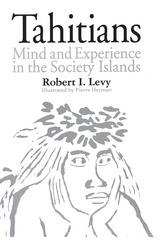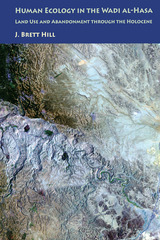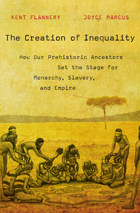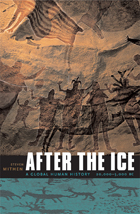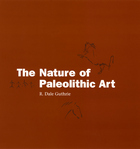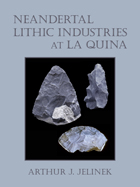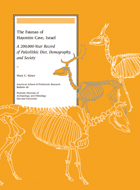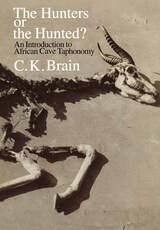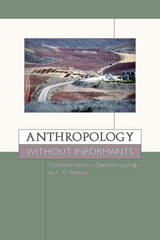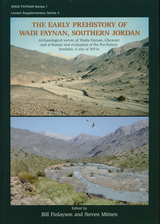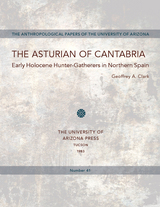Paper: 978-0-87365-553-8
Library of Congress Classification GN772.2.M6K43 2007
Dewey Decimal Classification 933
The Levantine corridor sits at the continental crossroads of Africa and Eurasia, making it a focal point for scientific inquiry into the emergence of modern humans and their relations with Neanderthals. The recent excavations at Kebara Cave in Israel, undertaken by an international, interdisciplinary team of researchers, has provided data crucial for understanding the cognitive and behavioral differences between archaic and modern humans.
In this first of two volumes, the authors discuss site formation processes, subsistence strategies, land-use patterns, and intrasite organization. Hearths and faunal remains reveal a dynamic and changing settlement system during the late Mousterian period, when Kebara Cave served as a major encampment. The research at Kebara Cave allows archaeologists to document the variability observed in settlement, subsistence, and technological strategies of the Late Middle and early Upper Paleolithic periods in the Levant.
Contents n List of Figures List of Tables Preface Ofer Bar-Yosef and Bernard Vandermeersch 000 acknowledgments references chapter one Introduction: The Framework of the Project 000 Ofer Bar-Yosef and Bernard Vandermeersch 000 the initial goals of the project the paleoanthropological debate archaeological observations and cultural definitions the chronology of the late middle and upper pleistocene summary references chapter two History of the Excavations at Kebara Cave Ofer Bar-Yosef and Bernard Vandermeersch 000 the location of kebara cave and its environment the 1931 excavations by f. turville-petre the excavations of m. stekelis aims and field techniques of the recent excavations (1982[\#208>1990) references chapter three Integrating the Archaeological Observations of the Two Projects Ofer Bar-Yosef and Liliane Meignen 000 designing the excavation strategy the horizontal excavation: the d¿capage the complex stratigraphy: integrating observations concerning the middle and upper paleolithic deposits lesson for the future references chapter four Stratigraphy and Geoarchaeological History of Kebara Cave, Mount Carmel Paul Goldberg, Henri Laville, Liliane Meignen, and Ofer Bar-Yosef 000 introduction deposits and stratigraphic framework western sector West Profile ensemble 6 (units xvi and xv) Unit XVI Unit XV ensemble 5 (unit xiv) ensemble 2 (units xiii to vii) Unit XIII Units VII through XII entrance sector Ensemble 1 (Units VI, V, Vr) Summary of the Entrance Area exterior sounding fissure filling Summary for Western Sector northern sector Western Part eastern sector northeastern area (square f/h/10/12) sector: the d¿capage southern and eastern sectors Southwest Corner South Profile the eastern sector Mousterian Deposits Exposed East of the D¿capage middle paleolithic and upper paleolithic deposits in the east profile middle and upper paleolithic sediments in the northeast sector summary of east sector geoarchaeological history at Kebara Stage 1: Accumulation of Basal Sediments Stage 2, Early Subsidence Event Stage 3: Accumulation of Sediments from Ensemble 2 Stage 4: Early Slumping Events Stage 5: The Major Subsidence Event and Filling of the Depression phosphatization conclusion references chapter five The Hearths at Kebara Cave and Their Role in Site Formation Processes Liliane Meignen, Paul Goldberg, and Ofer Bar-Yosef 000 introduction kebara cave macroscopic and microscopic descriptions of different types of structures and their interpretations Intact Hearths Medium-size Hearths Large-size Hearths Superposition of Small, In Situ Areas of Combustion Large Accumulations of Exclusively White Ashes White, Continuous Granular, Clay-rich Ashy Layers Rich in Bone and Tools Possible Secondary Areas of Combustion discussion and conclusion references appendix 5a: microscopic criteria for different types features Sample 90-1 Sample 83-4 Sample 84-29 Sample 96-12 Sample 96-13 Sample 84-26 Sample 89-19 Sample 84-28(1) Sample 89-18 Sample 85-6 Sample 90-6 Sample 89-4 Sample 85-28 Sample 85-25 Sample KEB 96-5b Sample 96-6a chapter six An Archaeomagnetic Study of Two Hearths from Kebara Cave, Israel Rob Sternberg and Egon H. E. Lass 000 introduction methods results RockMagnetism Paleomagnetism discussion references chapter seven Mineral Distributions in Kebara Cave: Diagenesis and Its Affect on the Archaeological Record Steve Weiner, Francesco Berna, Illit Cohen, Ruth Shahack-Gross, Rosa M. Albert, Panagiotis Karkanas, Liliane Meignen, and Ofer Bar-Yosef 000 introduction distribution of the primary constituents Artifacts Bones Hearths, Ash, and Charcoal Phytoliths distribution of the secondary components the stability field concept and its implications for bone diagenesis the early diagenesis model: the importance of degrading organic matter and hydrology archaeological implications Periods of Occupation and Non-Occupation Ash Formation and Dissolution Bone Preservation The Archaeobotanical Record Implications for TL and ESR Dating concluding comment acknowledgments references > chapter eight The Use of Plant Materials in Kebara Cave: Phytoliths and Mineralogical Analysis Rosa M. Albert, Ofer Bar-Yosef, and Steve Weiner 000 introduction materials and methods Choice of Samples Methods results Mineralogy Phytoliths discussion Phytolith Preservation Phytolith Analysis conclusions acknowledgments references chapter nine The Middle Paleolithic Occupations at Kebara Cave: A Faunal Perspective John D. Speth and Eitan Tchernov 000 introduction background and methods taphonomy hunting versus scavenging ungulate mortality patterns transport patterns the middle paleolithic occupations at kebara cave Major Prey Species sex ratios and seasonality transport and processing spatial organization temporal change tortoises summary and conclusions acknowledgments references cited chapter ten Cementum Increment Analysis of Ungulate Teeth from the Kebara Cave Faunal Assemblages: Discriminating Seasonal Signals from Their Diagenetic Mimics Aaron Stutz and Daniel E. Lieberman 000 introduction background biological basis methodological challenges Variation Diagenesis chemical diagenesis and cementum in kebara's archaeological teeth materials and methods a case study of specimen K5665 sample-wide preservation patterns discussion Seasonal Gazelle Hunting in the Upper Paleolithic Seasonal Gazelle Hunting in the Middle Paleolithic conclusions acknowledgments references chapter eleven Kebara Cave: An Interim Summary Ofer Bar-Yosef, Liliane Meignen, Paul Goldberg, and John D. Speth 000 introduction Figures P.1 Kebara cave in Mt. Carmel, a view from the west 000 1.1 A map of the Levant indicating the location of most known Middle Paleolithic sites as well as a few older ones mentioned in the text 000 1.2 The previously held chronologies for the Middle Paleolithic in the central Levant , based on Garrod 1962, Howell 1959, Copeland, Farrand 1979 and Jelinek 1981. Please note that not all the different versions of each author were summarized in this table 000 1. 3 The current chronology of the Levantine Middle Paleolithic as based on TL and ESR dates with the position of the main fossils 000 2.1 A map of Mt Carmel area with all the known Middle Paleolithic sites (after Olami 1984) 000 2.2 Kebara cave a view from the west, from far away 000 2.3 A simplified geological map of Mt. Carmel 000 2.4 Map of Kebara cave with the Stekelis and the new grid systems. The heavy black line is the wall of the cave as drawn at the level when M. Stekelis started (see also Fig. 2.7). The broken lines in the northern portion designate the cave wall in the area of the "niche" (see also Fig. 2.10) 000 2.5 Schematic section through Kebara cave 000 2.6 Map of Kebara cave as drawn by Turville-Petre (after Garrod 1954) 000 2.7 Kebara cave with the grid of M.Stekelis as well as the recent one, demostrating the location of the rockfall at the cave's entrance, as well as the levels at the beginning of Stekelis excavations 000 2.8 General view of Stekelis excavations in 1958 (photo: Kebara archives) 000 2.9 Genral view of the excavations in (1954). Note the 2x2 m squares (photo: Kebara archives) 000 2.10 Note the trench on the left which was the original one dug in 1951, and the area near the northern wall, which was later called the "niche" (photo: Kebara archives) 000 2.11 The area of the entrance, a view toward the west (1954). Note the large rockfall (photo: M.Stekelis) 000 2.12 The sieving in front of the cave in 1953 (photo: Kebara archives) 000 2.13a The "niche" area as defined by M. Stekelis in 1953 (photo: Kebara archives) 000 2.13b The "niche" area in 1965 (photo: Kebara archives) 000 2.14 A map showing the "hearths" as defined by Stekelis. For further discussion of these phenomena see Chapter 5 and Part II 000 2.15 The excavations in Kebara 1990 (photo: Kebara archives) 000 3.1 Map of Kebara cave showing the surface of the recent excavations and the two grid systems, the one employed by M. Stekelis of 2 x 2 m and ours (1 x 1 m) 000 3.2 view of the center of the excavations showing the D¿capage , the quasi horizontal area 000 3.3 An example for the excavation in process. Note the square meters and the recording of the finds in place 000 3.4 The late Dr. Irene Sala in course of excavting a square in the northern part of the central area 000 3.5 The water sieving, flottation and drying the of the sediments in front of the cave before picking 000 3.6 The field laboratory inside the cave in action 000 3.7 A view of a bone concentration in the D¿capage area 000 3.8 The western section as drawn by M. Stekelis (from Schick and Stekelis 1977) which conveys the impression of the layers being horizontal 000 3.9 Reconstructed topography of the unconformity between the Middle and Upper Paleolithic depositional units, as done on the basis of field observation, section drawing from the Stekelis archives and information about the presence of Upper Paleolithic artifacts near the northern wall. schematic map of the upper limit of MP sediments, in Stekelis and our excavations 000 3.10 A view of Kebara excavations during the last field season 000 4.1 Plan of Kebara Cave showing locations of sectors and profiles discussed in the text 000 4.2 View looking NW toward the entrance of Kebara and the Western area close to the end of the excavations 000 4.3 Kebara Cave looking toward the interior from the entrance. The large section opposite is the East Profile 000 4.4 General cross-section of the cave illustrating the major stratigraphic units as recognized by Turville-Petre, and the limits of the recent excavations 000 4.5 Semi-schematic block diagram of excavated area of Kebara close to the end of the excavations 000 4.6 Composite Western Profile illustrating deposits exposed in a number of closely situated sections 000 4.7 View of southern face of the Deep Sounding showing the basal geogenic deposits of Kebara 000 4.8 Composite Profile along south side of exposures in North Area 000 4.9 Close up of Units XV and XVI. ( POSSIBLY NEEDS COPYRIGHT PERMISSION FROM PLENUM: FROM AKAZAWA VOLUME, P. 111, FIG. 3) [Editor: Advise Ofer Bar-Yosef to seek permission using Peabody Museum Press form letter asap.] 000 4.10a Photomacrograph of quartzose sand adhering to bedrock at base of section within deep sounding. Width of view is ca. 75 mm 000 4.10b Detail of lower part of Fig. 5a showing angular, well sorted sand with diagenetically altered bedded silt at the left-hand part of the photograph 000 4.11 Photomicrograph of thin section of finely laminated deposits shown in Fig. 4-9 000 4.12 West profile along Sq. F G H I 19/20 showing the generally geogenic sediments and the relatively few burned areas 000 4.13 Photomicrograph of organic layer from Unit XIV in northern area 000 4.14 Deep Sounding showing contact between sterile, bedded silty deposits of Unit XIV 000 4.15 Stepped excavated surfaces, starting with Sq. I 19 in the foreground and looking south 000 4.16 South part of West Profile (Sq. M N O 20/21) showing a series of bedded burned layers dipping toward the south 000 4.17 Northern part of Western profile, Units V, VI, VII and VIII 000 4.18 Southwest corner of the central area of the site (Sq. Q20) 000 4.19 Entrance area of the cave looking northwest. The approximate contacts between Units is shown on the right 000 4.20a Closer view of the entrance sediments shown along the middle of M and the L/M line, looking north 000 4.20b Closer look at entrance sediments in the L/M line 000 4.21 A view toward the entrance of the cave as runoff generated during a thunderstorm in October, 1984 enters the cave 000 4.22 Photomicrograph of sediment from the top of Unit Vr showing aggregates of fresh terra rossa silty clay (TR), bone (B) and a carnivore coprolite (presumably hyaena) in the center (C) 000 4.23 Photo of dipping hearths in Sq. I13 and I 14 000 4.24 Northeastern part of excavation 000 4.25 Map showing the distribution of vertical hearths in the Decapage area 000 4.26a The D¿capage area looking north 000 4.26b Southwest corner of the d¿capage are that includes a part of the West Profile in the upper part of the photo 000 4.27 The South Profile, showing the finely laminated, water-laid nature of the Upper Palaeolithic sediments in the section 000 4.28a View of South (right) and East Profiles. Note the finely laminated Upper Palaeolithic deposits, which dip toward the back of the cave 000 4.28b Full frontal view of the South Profile 000 4.29 Photomicrograph of sediments from Unit VI in S Profile 000 4.30a Macrophotograph of well bedded Upper Palaeolithic sediments sample 90-22 from Unit III along the South Profile 000 4.30b Photomicrograph of sample 90-22 showing mixture of components 000 4.30c Same as Fig. 4-30b but in XPL. The bright color of the rubefied aggregates can be seen here as well as the distinct bedding of the fine quartz sand at the base of the photograph 000 4.30d Photomicrograph of sample 90-22 showing rounded terra rossa grain in the same bed as a piece of charcoal to the left. PPL; width of field is ca. 6.4 mm 000 4.30f Detail of Fig. 4-30d showing bright rounded terra rossa grain and angular, black pieces of charcoal to the right of it. PPL; width of field is ca. 3.2 mm 000 4.31 Photomicrograph of well bedded Upper Palaeolithic sediments from Unit I along the South Profile 000 4.32 Composite section of the Eastern Profile 000 4.33 East Profile corresponding to panels "a" and "c" in Fig. 8 000 4.34 Composite photograph from trench in Sq. L, M, N 14 000 4.35 Northeast corner. The part of the photo on the right corresponds to panel "e" of Fig. 4-32 000 4.36 Detailed view of Sq. J10 in northeast corner of site showing calcite (and some apatite) cemented Middle Palaeolithic bone rich red silty clays at the left 000 4.37a Macrophotograph of sample Keb-86-27 from SQ. L13, d=-520, showing laminated nature of sample 000 4.37b Photomicrograph of Fig. 4-37a showing alternately banded of light and dark brown partially compact silts with charcoal and organic matter 000 4.37c Detail of Fig. 4-37b showing flecks of organic matter and bedded material at the base. PPL; width of field is ca. 1.3 mm 000 4.37d High magnification view of sample Keb-86-27 showing diatom in the center of the photograph 000 4.38 View of Units IX(?) and X exposed along the south face of part of the Sondage (Square N18/19) 000 5.1 Western section showing superposition of burning features and layers 000 5.2 Deep Sounding with superposition and imbrication of burning features shown by layers of dark, charcoal and white, ash 000 5.3 Deep Sounding with superposition of hearths of varying thicknesses 000 5.4 Deep Sounding, plan view of unit XIII illustrating partially superposed fireplaces 000 5.5 Deep Sounding, unit XIII illustrating detailed map of imbricated hearths shown in fig.5.4 000 5.6 D¿capage, unit X with two partially superposed fireplaces 000 5.7 Deep Sounding, unit XIII showing detailed map of small fireplaces around a larger one 000 5.8 Deep Sounding unit XIII, south section illustrating a large basin-shaped "hearth" with successive combustion events 000 5.9 Deep Sounding unit XIII, south section - detail of Fig. 5.8 000 5.10 Deep Sounding - successive medium-sized purposefully prepared hearths in a basin-shaped depression 000 5.11 North-eastern area of unit XI showing an isolated hearth with carbonaceous rim 000 5.12 Western section showing erosion between units VI/VII with infilling and water reworking of bedded ashy sediments 000 5.13 Macroscan of thin section Keb90-1 000 5.14 Macroscan of thin section Keb83-4 000 5.15 Photomicrograph of thin section Keb83-4 000 5.16 Macroscan of thin section Keb84-29 000 5.17 Photomicrograph of thin section Keb84-29 000 5.18 North-western area, sq. I20 unit IX with large hearth of mostly white ashes 000 5.19 Deep Sounding, unit XII showing large basin-like "hearth", ca. 80 cm in diameter 000 5.20 Macroscan of thin section Keb96-12 000 5.21 Photomicrograph of thin section Keb96-12a 000 5.22 Macroscan of thin section Keb96-13b 000 5.23 Photomicrograph of thin section Keb96-13b 000 5.24 Deep Sounding unit XI, eastern section with superposition of numerous in situ hearths and stepped-like faults 000 5.25 Macroscan of thin section Keb84-26 000 5.26 Photomicrograph of thin section Keb84-26 000 5.27 Photomicrograph of thin section Keb84-26 000 5.28 Macroscan of thin section Keb89-19 000 5.29 Photomicrograph of thin section Keb89-19 000 5.30 Macroscan of thin section Keb84-28 000 5.31 Photomicrograph of thin section Keb84-28-1 000 5.32 Photomicrograph of thin section different area in Keb84-28-1 000 5.33 Northern area, close to the "kitchen-midden" zone with 80 cm thick accumulation of white ashes 000 5.34 Macroscan of thin section Keb89-18 000 5.35 Photomicrograph of thin section Keb89-18 in plane polarized light 000 5.36 Photomicrograph of thin section Keb89-18 in cross polarized light 000 5.37 Northern area, sq.H21 unit VII, showing the surface of cm-thick beds of grayish and reddish ash-rich deposits 000 5.38 Macroscan of thin section Keb85-6 000 5.39 Photomicrograph of thin section Keb85-6 000 5.40 Macroscan of thin section Keb90-6 000 5.41 Photomicrograph of thin section Keb90-6 000 5.42 Deep Sounding, western section, showing differences in thickness of the numerous superposed burning features 000 5.43 Deep Sounding, detail of the western section, with grey ashy sediments and charcoal interstratified with lenticular hearths 000 5.44 Macroscan of thin section Keb89-4 000 5.45 Photomicrograph of thin section Keb89-4 000 5.46 Macroscan of thin section Keb85-28 000 5.47 Photomicrograph of thin section Keb85-28 000 5.48 Photomicrograph of different area of thin section Keb85-28 000 5.49 Macroscan of thin section Keb85-25 000 5.50 Photomicrograph of thin section Keb85-25-1 000 5.51 Macroscan of thin section Keb96-5b 000 5.52 Photomicrograph of thin section Keb96-5b 000 5.53 Macroscan of thin section Keb96-6a 000 5.54 Photomicrograph of thin section Keb96-6a 000 5.55 Macroscan of thin section Keb90-5 000 5.56:Macroscan of thin section Keb90-5 000 5.57 Macroscan of thin section Keb90-21 000 5.58 Fireplace at Touareg campsite, Tassili, Algeria 000 6.1 The maximum IRM strength for Kebara samples 000 6.2 The MDFs for the six Kebara pilot demagnetization samples are 14, 16 and 17 mT for KB001, and 18, 26 and 38 mT for KB002 000 6.3 The vector component diagrams for KBOO1 000 6.4 The mean directions at the optimal demagnetization steps 000 7.1 Map of Kebara Cave showing excavated areas, and the locations of bone concentrations (rastered areas) 000 7.2 Photograph of the central Decapage area viewed in the north west direction 000 7.3 Photograph of hearths in a vertical section Note that many of the hearths are underlain by dark coloured layers. Scale bar : 20 cm intervals 000 7.4 Distribution of the major mineral components of the hearths analysed 000 7.5 Distribution of major mineral phases in the sediments and hearths analysed 000 7.6 The mineral distribution in the central Decapage area 000 7.7 Schematic diagram showing the common primary and secondary minerals found in archaeological sites 000 7.8 Stability field diagram adapted from Karkanas et al (2000) 000 7.9 Plane view of the Decapage area showing the locations of the sediment samples (O) that contain carbonated apatite in relation to the locations of the 3 bone concentrations 000 8.1 / Photograph of a section in Kebara cave showing the superimposed hearths with different colors 000 8.2 - Map of Kebara cave with the excavation grid squares, showing the locations of the samples studied. A 000 8.3 Histogram showing the percentages of the main morphological groups in which phytoliths were divided from Mousterian and Upper Paleolithic samples 000 8.4 Histogram showing the percentage of grass phytoliths in the Mousterian and Upper Paleolithic levels of the total assemblage of consistent morphology phytoliths identified in the archaeological samples 000 8.5 Photomicrographs of phytoliths identified in Kebara sediments and in the modern plant reference collection 000 8.6 Photomicrographs of phytoliths identified in Kebara samples and in the modern plant reference collection 000 8.7 Histogram showing the weight % volume of vegetal material derived from grasses, leaves and wood/bark in the hearths from the Mousterian samples 000 9.1 Frequency of gazelle and fallow deer distal humeri and distal tibias in the Middle and Upper Paleolithic (NISP) 000 9.2 Proportion of carnivore-damaged bones in the Middle and Upper Paleolithic assemblages (NISP) 000 9.3 Skeletal element frequencies in the Middle and Upper Paleolithic (NISP, gazelle only) 000 9.4 Skeletal element frequencies in the Middle and Upper Paleolithic (NISP, fallow deer only) 000 9.5 Skeletal element frequencies in the Middle and Upper Paleolithic (NISP, red deer only) 000 9.6 Proportion of cutmarked bones in the Middle and Upper Paleolithic assemblages (NISP) 000 9.7 Proportion of burned bones in the Middle and Upper Paleolithic assemblages (NISP) 000 9.8 Proportion of cutmarked bones by anatomical unit in the Middle and Upper Paleolithic assemblages (NISP, gazelle only) 000 9.9 Proportion of cutmarked bones by anatomical unit in the Middle and Upper Paleolithic assemblages (NISP, fallow deer only) 000 9.10 Proportion of cutmarked bones by anatomical unit in the Middle and Upper Paleolithic assemblages (NISP, red deer only) 000 9.11 Frequency of gazelle and fallow deer bones by anatomical unit in the Middle Paleolithic (MNI) 000 9.12 Ternary diagram showing prey age classes taken by modern non-human cursorial and ambush predators (after Stiner 1994) 000 9.13 Ternary diagram showing prey age classes taken by Italian Middle and Upper Paleolithic hominids (after Stiner 1994) 000 9.14 Ternary diagram showing prey age classes taken by Kebara Middle and Upper Paleolithic hominids (based on dP4 and P4) 000 9.15 Ternary diagram showing prey age classes, grouped into "early" (units IX - XIII) and "late" (units VI - VIII) geologically defined stratigraphic units, taken by Kebara Middle and Upper Paleolithic hominids (based on dP4 and P4) 000 9.16 Ternary diagram showing prey age classes, grouped by arbitrary horizontal half- meter level, taken by Kebara Middle and Upper Paleolithic hominids (gazelle only, based on dP4 and P4) 000 9.17 Ternary diagram showing prey age classes, grouped by arbitrary horizontal half- meter level, taken by Kebara Middle and Upper Paleolithic hominids (fallow deer only, based on dP4 and P4) 000 9.18 Scattergram of head-to-limb ratio ([H+H]/L) plotted against ratio of prime to old adults for Italian Middle and Upper Paleolithic assemblages (after Stiner 1994) 000 9.19 Scattergram of Index of Skeletal Completeness (tMNE/MNI) plotted against head- to-limb ratio ([H+H]/L) for Italian Middle and Upper Paleolithic assemblages (after Stiner 1994) 000 9.20 Scattergram of head-to-limb ratio ([H+H]/L) plotted against ratio of prime to old adults for Kebara Middle Paleolithic assemblages 000 9.21 Scattergram of Index of (Relative) Skeletal Completeness (tMNE/MNI) plotted against head-to-limb ratio ([H+H]/L) for Kebara Middle Paleolithic assemblages 000 9.22 Scattergram of head-to-limb ratio ([H+H]/L) plotted against ratio of prime to old adults, grouped by arbitrary horizontal one-meter level, for Kebara Middle Paleolithic assemblages (gazelle only) 000 9.23 Scattergram of head-to-limb ratio ([H+H]/L) plotted against ratio of prime to old adults, grouped by arbitrary horizontal one-meter level, for Kebara Middle Paleolithic assemblages (fallow deer only) 000 9.24 Scattergram of Index of (Relative) Skeletal Completeness (tMNE/MNI) plotted against head-to-limb ratio ([H+H]/L), grouped by arbitrary horizontal one-meter level, for Kebara Middle Paleolithic assemblages (gazelle only) 000 9.25 Scattergram of Index of (Relative) Skeletal Completeness (tMNE/MNI) plotted against head-to-limb ratio ([H+H]/L), grouped by arbitrary horizontal one-meter level, for Kebara Middle Paleolithic assemblages (fallow deer only) 000 9.26 Pie diagram showing proportions of major taxa at Kebara (NISP, based on dP4, P4, and M3) 000 9.27 Pie diagram showing proportions of major taxa at Kebara, grouped into "lower" (units IX - XIII) and "upper" (units VI - VIII) geologically defined stratigraphic units (NISP, based on dP4, P4, and M3) 000 9.28 Taxonomic composition of Kebara fauna plotted against geologically defined stratigraphic units (NISP, based on dP4, P4, and M3) 000 9.29 Taxonomic composition of Kebara fauna plotted against geologically defined stratigraphic units (NISP, based on phalanges 1 - 3) 000 9.30 Taxonomic composition of Kebara fauna plotted against arbitrary horizontal half- meter levels (NISP, based on dP4, P4, and M3) 000 9.31 Taxonomic composition of Kebara fauna plotted against arbitrary horizontal half- meter levels (NISP, based on phalanges 1 - 3) 000 9.32 Sex determination in fallow deer (humerus): scattergram of distal breadth (mm) plotted against minimum diameter of trochlea (mm) 000 9.33 Sex determination in fallow deer (metacarpal): scattergram of distal breadth (mm) plotted against distal depth (mm) 000 9.34 Sex determination in fallow deer (astragalus): histogram of Greatest Length of Lateral Half (GLl, mm, after von den Driesch 1976) 000 9.35 Sex determination in fallow deer (astragalus): histogram of Greatest Depth of Lateral Half (Dl, mm, after von den Driesch 1976) 000 9.36 Sex determination in fallow deer (astragalus): scattergram of Greatest Length of Lateral Half (GLl, mm) plotted against Greatest Depth of Lateral Half (Dl, mm) 000 9.37 Sex ratio (male) of gazelle, and proportion of immature gazelle, plotted against arbitrary horizontal half-meter levels (NISP) 000 9.38 Sex ratio (male) of fallow deer, and proportion of immature fallow deer, plotted against arbitrary horizontal half-meter levels (NISP) 000 9.39 Sex ratio (male) of both gazelle and fallow deer plotted against arbitrary horizontal half-meter levels (NISP) 000 9.40 Sex ratio (male) of fallow deer antlers plotted against arbitrary horizontal one- meter levels (NISP) 000 9.41 Frequency of juvenile and adult maxillae expressed as a proportion of total maxillary and mandibular fragments (NISP, includes isolated teeth) 000 9.42 Frequency of moderate- to high-utility marrow bones (phalanges 1 - 2 and metapodials), expressed as a proportion of total phalanges, metapodials and large tarsals (astragali, calcanei, naviculo-cuboids) (NISP) 000 9.43 Proportion of cutmarked bones by anatomical unit (NISP) 000 9.44 Proportion of cutmarked upper and low limb bones by age class (NISP) 000 9.45 Proportion of burned bones by anatomical unit (NISP) 000 9.46 Proportion of burned bones by age class and body size at Kebara Cave (NISP) 000 9.47 Proportion of burned bones by age class and body size at late prehistoric (AD 1300) Henderson Site (USA) (NISP) 000 9.48 Mean maximum fragment length (cm) in north wall and central floor areas (unburned only, excluding isolated teeth) 000 9.49 Frequency of bulky, low-utility skeletal elements (heads) in north wall area, expressed as a proportion of total heads in the north wall and central floor areas (NISP); and frequency of high-utility skeletal elements (metapodials) in north wall area, expressed as a proportion of total metapodials in the north wall and central floor areas (NISP) 000 9.50 Frequency of complete (unbroken) phalanges 1 - 2 in north area, expressed as a proportion of total phalanges 1 - 2 (broken and unbroken) in the north wall area (NISP); and frequency of complete (unbroken) phalanges 1 - 2 in central area, expressed as a proportion of total phalanges 1 - 2 (broken and unbroken) in the central area (NISP) 000 9.51 Proportion of burned bones in the north wall and central floor areas by body size (NISP, excluding isolated teeth) 000 9.52 Proportion of burned bones in the north wall and central floor areas plotted against arbitrary horizontal half-meter levels (NISP, gazelle only, excluding isolated teeth) 000 9.53 Proportion of burned bones in the north wall and central floor areas plotted against arbitrary horizontal half-meter levels (NISP, fallow deer only, excluding isolated teeth) 000 9.54 Proportion of carnivore-damaged bones plotted against arbitrary horizontal half- meter levels (NISP, all taxa, excluding isolated teeth) 000 9.55 Mean maximum fragment length (cm) plotted against arbitrary horizontal half- meter levels (gazelle and fallow deer, unburned, excluding isolated teeth) 000 9.56 Mean maximum fragment length (cm) plotted against geologically defined stratigraphic units (fallow deer only, unburned, excluding isolated teeth) 000 9.57 Proportion of foxes and other carnivores plotted against arbitrary horizontal half- meter levels (NISP) 000 9.58 Proportion of bulky, low-utility skeletal elements (heads) plotted against arbitrary horizontal half-meter levels (NISP) 000 9.59 Mean standardized marrow index plotted against arbitrary horizontal half-meter levels (all taxa) 000 9.60 Index of (Relative) Skeletal Completeness (tMNE/MNI) plotted against arbitrary horizontal half-meter levels 000 9.61 General Index of Transport Constraints (H/[H+T]) for woodland and grassland forms plotted against arbitrary horizontal half-meter levels (NISP) 000 9.62 Cranial Index of Transport Constraints (Max/[Max+Man]) for woodland and grassland forms plotted against arbitrary horizontal half-meter levels (NISP) 000 9.63 Burned Middle Paleolithic marginal (peripheral) carapace segment (dorsal and ventral view) from Kebara Cave 000 9.64 Proportion of tortoise bones in each geologically defined Middle Paleolithic stratigraphic unit, expressed as a percentage of the total number of tortoise bones assigned to a specific unit recovered by the Bar-Yosef and Vandermeersch excavations (%NISP) 000 10.1 Longitudinal cross section through a typical adult bovid molar, with cementum illustrated in oral anatomical context 000 10.2 Cementum in dental context in longitudinal cross sections 000 10.3 Schematized dental cross sections of three cementum zones that exhibit seasonal incremental banding in mammal teeth 000 10.4 Acellular cementum (AC) increments defined by variations in Sharpey's fiber orientation 000 10.5 Polarizing transmitting light photomicrographs of a thin section through the distal root of case study specimen K5665, a gazelle P4 from the Upper Paleolithic layers of Kebara Cave (see Lieberman 1993b) 000 Tables [Editor: Augment list of tables with tables from chapters other than chapter 9.] 9.1 Frequency of gazelle and fallow deer distal humeri and distal tibias in the Middle and Upper Paleolithic (NISP) 000 9.2 Frequency of cutmarked and carnivore-damaged bones by taxon in the Middle and Upper Paleolithic 000 9.3 Frequency of gazelle, fallow deer, and red deer bones by anatomical unit in the Middle and Upper Paleolithic 000 9.4 Frequency of burned bones by taxon in the Middle and Upper Paleolithic 000 9.5 Frequency of cutmarked gazelle bones by anatomical unit in the Middle and Upper Paleolithic 000 9.6 Frequency of cutmarked fallow deer bones by anatomical unit in the Middle and Upper Paleolithic 000 9.7 Frequency of cutmarked red deer bones by anatomical unit in the Middle and Upper Paleolithic 000 9.8 Frequency of gazelle and fallow deer bones by anatomical unit in the Middle Paleolithic (MNI) 000 9.9 Frequency of juvenile, prime old, and old adult animals, based on lower dP4 and lower P4, in the Middle and Upper Paleolithic 000 9.10 Frequency of juvenile, prime old, and old adult animals, based on lower dP4 and lower P4, grouped into "Upper" and "Lower" stratigraphic units in the Middle Paleolithic 000 9.11 Frequency of juvenile, prime old, and old adult gazelle, based on lower dP4 and lower P4, by arbitrary horizontal half-meter level in the Middle and Upper Paleolithic 000 9.12 Frequency of juvenile, prime old, and old adult fallow deer, based on lower dP4 and lower P4, by arbitrary horizontal half-meter level in the Middle and Upper Paleolithic 000 9.13 Minimum number of skeletal elements (MNE) by anatomical unit and summary indices discussed in text 000 9.14 Summary indices for gazelle and fallow deer by arbitrary horizontal one-meter level 000 9.15 Frequency of five major taxa in the Middle and Upper Paleolithic 000 9.16 Frequency of five major taxa by stratigraphic unit in the Middle and Upper Paleolithic 000 9.17 Frequency of five major taxa by arbitrary horizontal half-meter level in the Middle and Upper Paleolithic 000 9.18 Sex and age composition of gazelle and fallow deer bones by arbitrary horizontal half-meter level in the Middle and Upper Paleolithic 000 9.19 Frequency of juvenile and adult maxillae and mandibles by taxon in the Middle Paleolithic 000 9.20 Frequency of high- versus low-utility elements by taxon in the Middle Paleolithic 000 9.21 Frequency of cutmarked bones by anatomical unit (grouped) in the Middle Paleolithic 000 9.22 Frequency of juvenile and adult cutmarked upper and lower limb elements by taxon in the Middle Paleolithic 000 9.23 Frequency of burned bones by anatomical unit (grouped) in the Middle Paleolithic 000 9.24 Frequency of burned bones by taxon and age class in the Middle Paleolithic at Kebara Cave (Israel) and in the late prehistoric at the Henderson Site (USA) 000 9.25 Frequency of burned bones and mean fragment length of unburned bones, by taxon, in north wall and central floor areas in the Middle Paleolithic 000 9.26 Frequency of heads and metapodials in the north wall and central floor areas by taxon in the Middle Paleolithic 000 9.27 Frequency of complete versus broken phalanges 1 - 2 by taxon in the north wall and central floor areas in the Middle Paleolithic 000 9.28 Frequency of burned gazelle and fallow deer bones in north wall and central floor areas by arbitrary horizontal half-meter level in the Middle Paleolithic 000 9.29 Frequency of carnivore-damaged bones (all taxa combined) by arbitrary horizontal half-meter level in the Middle and Upper Paleolithic 000 9.30 Maximum fragment length (mean) of gazelle and fallow deer bones by arbitrary horizontal half-meter level and natural stratigraphic unit in the Middle and Upper Paleolithic 000 9.31 Frequency of carnivore remains by arbitrary horizontal half-meter level in the Middle and Upper Paleolithic 000 9.32 Frequency of heads of gazelle, fallow deer, and red deer by arbitrary horizontal half-meter level in the Middle and Upper Paleolithic 000 9.33 Standardized Marrow Index (mean) by arbitrary horizontal half-meter level in the Middle and Upper Paleolithic 000 9.34 Index of (Relative) Skeletal Completeness (tMNE/MNI) for gazelle and fallow deer by arbitrary horizontal half-meter level in the Middle Paleolithic 000 9.35 General Index of Transport Constraints (H/[H+T]) in grassland and woodland taxa by arbitrary horizontal half-meter level in the Middle and Upper Paleolithic 000 9.36 Cranial Index of Transport Constraints (Max/[Max+Man]) in grassland and woodland taxa by arbitrary horizontal half-meter level in the Middle and Upper Paleolithic 000 9.37 Frequency of tortoise remains by geologically defined stratigraphic unit in the Middle and early Upper Paleolithic 000
See other books on: Bar-Yosef, Ofer | Carmel, Mount, Region | Israel | Mousterian culture | Paleolithic period
See other titles from Harvard University Press

